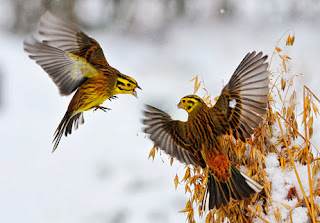I love those vivid yellowhammers who feature so prominently in Thomas Hardy’s poem ‘Self-Unconscious’: ‘Bright yellowhammers/Made mirthful clamours,/And billed long straws with a bustling air’, and so on across two stanzas. And D.H. Lawrence (who wrote a booklength study of Thomas Hardy) follows up this motif through Ursula Brangwen in Women in Love: ‘Some yellowhammers suddenly shot along the road in front of her. And they looked to her so uncanny and inhuman, like flaring yellow barbs shooting through the air on some weird, living errand, that she said to herself: “ … They are of another world. How stupid anthropomorphism is”’ (ch.XIX).
Birds are important for William Morris too; and Cormell Price once recorded in his diary that Morris could ‘go on for hours about their habits: but especially about their form’. But among the robins, thrushes, blackbirds, lapwings, wood-ouzels, herons, nightingales, moorhens, woodpeckers, kestrels, ernes, willow-warblers and others who enliven his pages and designs, I don’t recall any yellowhammers. Have I missed something in his voluminous works - some stray text or manuscript that hasn't yet been digitised, perhaps? Can anyone help with an apt reference? In The Well at the World’s End the Lady of Abundance shamefacedly tells Ralph that, as a girl, she had set snares for birds (‘though when I had caught them, it irked me sore to kill them’), so I here, more benignly, set a literary snare which may one day capture us a memorable yellowhammer reference in Morris’s vast oeuvre.
Wednesday, 19 March 2014
Subscribe to:
Post Comments (Atom)






2 comments:
Your point about birds as objects of anthropomorphism, especially yellowhammers, is an interesting one: there is something strange about birds that means when writing about them there seems to be a tendency to either dwell on what seems human about them (aka Ursula a few lines earlier than your quoted section, comparing the yellowhammers to pompous little politicians) or to dwell on the distance between us and them. I suppose it is because there is so much to separate birds and humans. I'm afraid I can't say much on the subject of William Morris, but D H Lawrence seems to vacillate between the two perspectives - but in my studies on Ted Hughes recently I've noticed he tends to focus on the 'inhuman' in birds, usually what is violent about them: their carnivorous beaks, their claws. Perhaps anthropomorphism becomes more and more unfashionable through the 20th century?
Thanks, Lenni. I certainly find Ted Hughes problematic too - in fact, I have an earlier post about him entitled 'Tearing off Heads' (a quote from one of his early hawk poems that I'm sure you'll be familar with) on 7 December 2011. We could trace the poetic history of the yellowhammer back behind Hardy to two poems by John Clare, 'The Yellowhammer' and 'The Yellowhammer's Nest'. If Wordsworth in his verse typically subdues the natural creature to his own "egotistical sublime" (as with Yeats's "Another emblem there" about the swans in his Coole Park poem), Clare, much more modestly, observes it with a naturalist's detailed, scrupulous and respectful care.
Post a Comment